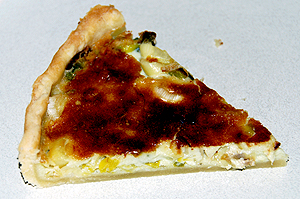OVEN-BAKED SAVORY TARTS
I used to use frozen puff pastry to make savory pies. After reading the labels carefully, I’ve stopped using pre-made pastry dough of any kind because most contain hydrogenated soybean and palm oils, as well as preservative. This means it’s more work. One way to get around this is to make pre-baked pie shells some morning when you have time, and freeze them so they’re ready to go when you need a quick supper. Find a container to protect them in the freezer, and wrap in double foil.
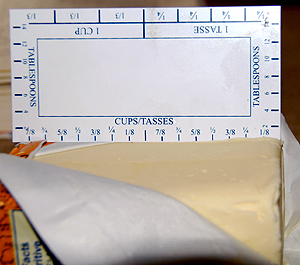
Many recipes for pastry call for butter plus either vegetable shortening or lard. I’ve substituted cream cheese for the latter — I tried all three, and although the shortening and lard versions are softer to roll out, the cream cheese version is actually easier to handle.
A food processor is a great boon when making pastry. The knives cut the butter and cream cheese into tiny bits coated with flour, exactly what’s needed for pastry. However, a pastry cutter or two knives can do the job almost as well, if you don’t own a food processor.
Equipment:
• a flexible plastic cutting board to use to roll out the pastry. I bought one for about $2, but you might want to go for the upmarket version, a silicone non-stick pastry sheet.
• a kitchen weigh scale. Measuring cups are less exact than weights (I have three that vary by as much as a whole tablespoon.) One pound of flour is about 3 ½ unsifted cups but it does depend on the flour. Butter and shortening are the same. Weights are more accurate, and in pastry it does matter.
• a plastic card called a butter measure, available for a dollar at Chantilly, is hugely useful for measuring tablespoons of butter or other solid shortening.
Ease is the point of savory pie: a simple supper or lunch dish that is easy to eat, great as left-overs, goes well with a little salad or a good loaf of bread. Use what you have in the house. If the ingredients are fresh, the cheese real (not pre-grated in a plastic bag) it will probably taste okay. Use any of these:
• onions; garlic; leeks
• chopped broccoli; spinach; cauliflower; peas; green beans; potato; squash, cubed and roasted first; red, green or yellow pepper
• cheddar; goat cheese; parmesan; mozzarella; blue veined cheese of any sort except perhaps Roquefort and Gorgonzola which may be too strong for most tastes
• chopped and sautéed ham, bacon, prosciutto, speck, sausage, chicken or shrimp
Pastry for savory tarts and pies
For one pie shell 9 to 12” in diametre
1 ¾ cups or ½ pound white all-purpose flour, unsifted
½ cup or 4 oz. butter, preferably unsalted, very cold
3 tbsp. cream cheese, very cold or frozen
½ cup of liquid made of one egg, beaten and cold water
¼ to ½ tsp. salt
Cut the butter and cream cheese into the flour using either a food processor or a pastry cutter or two knives in a bowl. Do not use your fingers
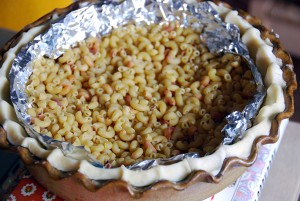
to shred the butter and cheese — they are too warm, and the point is to keep the little pieces of fat entire, and surrounded by flour.
Beat the egg and add water to ½ cup. Mix into the flour and butter very thoroughly. In a food processor, by pulsing the motor, you will end up with the dough forming into a ball in less than a minute. If using a bowl and fork, mix as little as possible to create a soft dough. Shape into a round flat ball and wrap in plastic wrap; chill for at least 2 minutes before rolling out.
Put 1 tbsp. flour onto a flexible cutting board or a piece of plastic wrap. Roll out the dough into a circle, more or less, so that the smallest part is at least an inch larger than your pie pan.
Cut the edges off, and turn the plastic sheet with the pie shell over on top of the pie pan. Gently put the shell into the pan. Shape the sides and tuck extra pastry down along the outside edge of the shell.
Line the shells with foil and weight it with barley, dried white beans, macaroni or pie weights.
Bake in a preheated 425° F oven for 20 minutes. Allow to cool before removing weights. Fill and bake as required, or freeze for future use.

Onion and roasted grape tomato tart
A very flavourful tart that can be made vegan by substituting black olives for the goat cheese in the filling, and vegetable shortening for butter and cheese in the pastry. If you add anchovies and black olives, you have pissaladière, a French version of pizza.
1 lb onions (3 large or 5 small)
1 whole bulb garlic, roasted
1 lb large tomatoes, skinned and chopped
1 ¼ lbs. grape tomatoes
2 tsp. balsamic Maletti vinegar
fresh basil and thyme, chopped
2 tbsp butter
4 oz. goat cheese
Peel and slice thinly the onions, and sauté in the butter until they begin to brown.
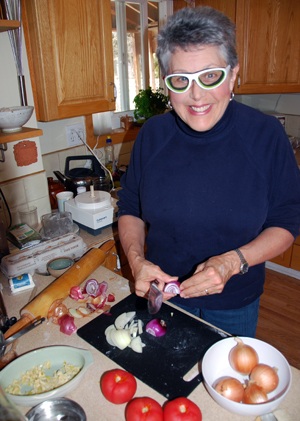
Skin the large tomatoes: plunge into boiling water for 3-4 minutes. The skins will split so that when you remove them from the water, you can easily peel them. Chop into ½ inch dice.
Slice the garlic bulb in half and roast in a 400° F oven for 15 minutes. When cool, squeeze the garlic out and put it into the pan with the onions. Add the chopped tomato and 1 tsp. balsamic vinegar. Continue to sauté until well blended to a puddingish consistency.
Roast the grape tomatoes: cut each one in half and put skin side down on a baking sheet. Grate some black pepper over them, and drizzle 1 tsp. of the balsamic over them. Roast at 400° F for 20 minutes.
To assemble the tart, put the onion-tomato-garlic mixture on the shell; arrange the roasted grape tomatoes, cut side up, on top. Mash the goat cheese and little, and distribute in small clumps more or less evenly over the grape tomatoes. Chop about 2 tbsp. of the basil and strew on top.
Bake in 425° F oven for 20-25 minutes.
Leek and Cheese Tart
In North China during the month of October, the sidewalks and parkways are lined with cabbages and leeks set out to dry in the fall sunshine. This photo of leeks was taken right beside my apartment door 16 months ago. I longed for an oven so that I could make this tart, which I finally did again this winter, using lovely fat leeks from Wildflight Farm.
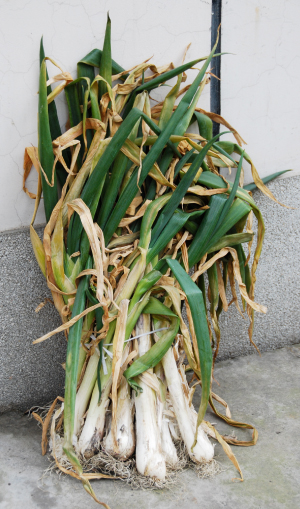
The classic but very simple recipe calls for Stilton and a springform pan. Cooper’s didn’t have any Stilton, so I used Rosenberg Castello Mellow Blue instead. You could equally well use aged cheddar, goat cheese or, for a very mild tart, plain cream cheese. If you don’t own a springform pan, use a normal pie plate.
Leeks need lots of cleaning — they grow in sand and mud, which often gets into the green and even the white part, between the rings of leek growth. If you get very sandy ones, chop first then put in a sieve and spray like mad, then drain and dry. Look for mud when chopping and be sure to remove it — nothing worse than biting into grit when you are expecting another mouthful of this smooth and delectable pie.
Make pastry crust, as above, in a 9” springform pan.
Sauté 2-3 sliced leeks in 3 tbsp. butter until transparent.
Put into a food processor and process ( or mix by hand) until smooth the following:
3 oz cheese
1 egg +1 egg yolk
½ cup whipping cream
Scatter the leeks across the pie crust.
Pour in the cheese-egg mixture and smooth with spatula.
Bake for 25 min at 400° F.
